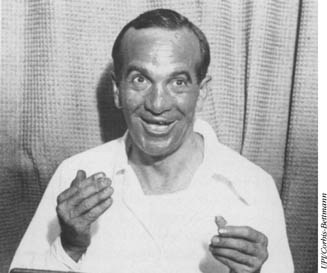
Al Jolson in a New York dressing room in 1930, applies his famous—or infamous—”Blackface” makeup.
When he exclaimed: “You ain’t heard nothin’ yet,” in the film The Jazz Singer (1927), Al Jolson wasn’t exaggerating. The world had never heard—or seen—anyone quite like the star of this, the first talking picture.
The man who called himself “The World’s Greatest Entertainer” had begun making good on that claim two decades before The Jazz Singer. During the early 1900s, Jolson had been a minstrel-show sensation and in the following decade became America’s biggest stage and recording star. His trademark gimmicks included blackface makeup and making dramatic gestures such as getting down on one knee with outstretched arms, while booming out shamelessly sentimental songs. With his overpowering personality, this maniacally energetic performer set new standards as an all-round entertainer and inspired a host of younger performers, most notably Bing CROSBY.
Jolson, was born Asa Yoelson, on May 26, 1886, in a log cabin on a dirt road in the village of Srednike, Lithuania. He was the fifth son of a local rabbi, and was deeply attached to his mother. After the family settled in New York City, his mother died—Asa was only eight. The Shockwaves of this tragedy reverberated throughout his life and, shortly after her death, he took up singing and acting. He did so with such determination that by 1898 he had made his showbiz debut at age 12, belting out “You Are My Jersey Lilly” from the gallery of a burlesque house. Newly renamed Al Jolson, he toured with his brother Harry in a vaudeville act, and around 1902 the two began blackening their faces in the minstrel tradition.
Soon after this, Jolson performed solo as “The Blackface with the Grand Opera Voice” and in 1908 joined Lew Dockstader’s minstrel show. After two years of honing his unique act, he launched his solo career in earnest with a typically self-confident announcement in Variety-. ”You’ve never heard of me, but you will.” In 1911, he became a stage star in Vera Violetta, the first of ten Broadway hits over the next two decades. His first million-seller came in 1912, with “Ragging the Baby to Sleep.” “The Spaniard Who Blighted My Life” was another great success. Jolson reached his peak of popularity starring in The Jazz Singer—singing “My Mammy”—and in the 1928 film, The Singing Fool—singing “Sonny Boy.”

Al Jolson in a New York dressing room in 1930, applies his famous—or infamous—”Blackface” makeup.
Although his career declined from the late 1920s, Jolson continued to be a popular performer right up to his much-mourned death on October 23, 1950, appear-ing on radio, touring, and providing the vocals (mouthed by actor Larry Parks) for two blockbuster film biographies, The Jolson Story (1946) and Jolson Sings Again (1949). Jolson’s larger-than-life persona and style not only inspired other entertainers and spawned countless impressionists, but created some of the most notable songs on record, and his renditions of “Swanee” and “April Showers,” have become classics.
Terry Atkinson
SEE ALSO:
FILM MUSICALS; MUSICALS; POPULAR MUSIC.
FURTHER READING
Fisher, James. Al Jolson (Westport, CT: Greenwood Press, 1994);
McClelland, Doug. Blackface to Blacklist (Metuchen, NJ: Scarecrow Press, 1987).
SUGGESTED LISTENING
The Best of the Decca Years; The Early Years; Steppin’ Out.